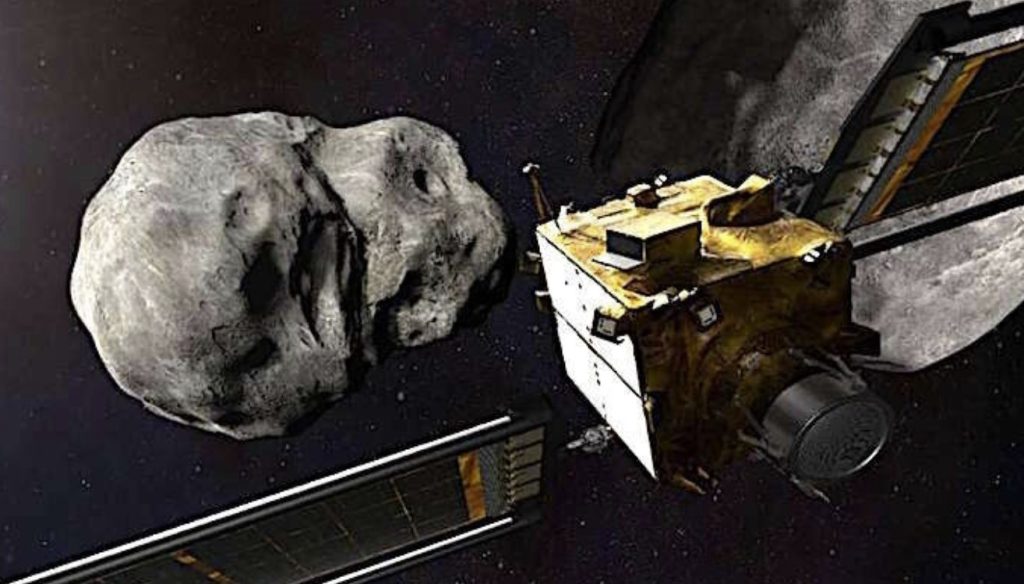
In the 1998 Hollywood blockbuster Armageddon, Bruce Willis and Ben Affleck race to save the Earth from being pulverized by an asteroid. Next year we will experience it live!
NASA plans to crash a spacecraft traveling at a speed of 15,000 miles per hour (24,000 kph) into an asteroid next year in a test of “planetary defense.”
The Double Asteroid Redirection Test (DART) is to determine whether this is an effective way to deflect the course of an asteroid should one threaten the Earth in the future.
NASA provided details of the DART mission, which carries a price tag of $330 million, in a briefing for reporters on Thursday. Lindley Johnson, NASA’s Planetary Defense Officer, said:
“Although there isn’t a currently known asteroid that’s on an impact course with the Earth, we do know that there is a large population of near-Earth asteroids out there. The key to planetary defence is finding them well before they are an impact threat. We don’t want to be in a situation where an asteroid is headed towards Earth and then have to test this capability.”
The DART spacecraft is scheduled to be launched aboard a SpaceX Falcon 9 rocket at 10:20 pm Pacific time on November 23 from Vandenberg Space Force Base in California.
If the launch takes place at or around that time, impact with the asteroid some 6.8 million miles from Earth would occur between September 26 and October 1 of next year.
DART target asteroid
The target asteroid, Dimorphos, which means “two forms” in Greek, is about 525 feet in diameter and orbits around a larger asteroid named Didymos, “twin” in Greek.
Johnson said that while neither asteroid poses a threat to Earth they are ideal candidates for the test because of the ability to observe them with ground-based telescopes. Images will also be collected by a miniature camera-equipped satellite contributed by the Italian Space Agency that will be ejected by the DART spacecraft 10 days before impact.
‘A small nudge’
Nancy Chabot of the Johns Hopkins Applied Physics Laboratory, which built the DART spacecraft, said Dimorphos completes an orbit around Didymos every 11 hours and 55 minutes “just like clockwork.”
The DART spacecraft, which will weigh 1,210 pounds at the time of impact, will not “destroy” the asteroid.
“It’s just going to give it a small nudge. It’s going to deflect its path around the larger asteroid. It’s only going to be a change of about one percent in that orbital period, so what was 11 hours and 55 minutes before might be like 11 hours and 45 minutes.”
The test is designed to help scientists understand how much momentum is needed to deflect an asteroid in the event one is headed towards Earth one day.
“We are targeting to be as nearly head on as possible to cause the biggest deflection,” Chabot said.
The amount of deflection will depend to a certain extent on the composition of Dimorphos and scientists are not entirely certain how porous the asteroid is.
Dimorphos is the most common type of asteroid in space and is some 4.5 billion years old, Chabot said.
“It’s like ordinary chondrite meteorites,” she said. “It’s a fine grain mixture of rock and metal together.”
Johnson, NASA’s Planetary Defense Officer, said more than 27,000 near-Earth asteroids have been catalogued but none currently pose a danger to the planet.
An asteroid discovered in 1999 known as Bennu that is 1,650 feet wide will pass within half the distance of the Earth to the Moon in the year 2135 but the probability of an impact is considered very slight.
How many near-Earth asteroids have been discovered so far?
At the start of 2019, the number of discovered near-Earth asteroids totaled more than 19,000. An average of 30 new discoveries are added each week.
The 15,000 milestone, reached on October 13, 2016, marked a 50 percent increase in the number of known near-Earth asteroids since 2013, when discoveries reached 10,000 in August of that year.
More than 95 percent of these objects were discovered by NASA-funded surveys (primarily using ground-based telescopes) since 1998, when NASA initially established its Near-Earth Object Observations Program and began tracking and cataloguing them.
Is it likely that an asteroid will impact Earth in the near future?
While no known asteroid larger than 140 meters in size has a significant chance to hit Earth for the next 100 years, only about 40 percent of those asteroids have been found to date.
How good are we at finding and tracking NEOs?
Since 2015, observers discovered more than 1500 previously unknown NEOs each year (over 2000 in 2017). Roughly half of the known catalogue of NEOs are objects larger than about 460 feet (140 meters) in size. The estimated population of NEOs of this size is about 25,000. Current surveys are finding NEOs of this size at a rate of about 500 per year.
The 460-foot cutoff point was established by a NASA NEO survey science definition team (SDT) in 2003 and reaffirmed in 2017. The SDT determined that impacts from objects of that size would only produce regional effects, while larger objects would have corresponding wider effects such as large sub-global effects from impacts of a 984-foot (300-meter) object and global effects from 0.6 mile (1-kilometer) object impacts.
Ground-based telescopes alone have limitations – for instance, they can only survey the skies at night and in clear skies. Based on statistical population estimates, about two thirds of NEOs larger than 460 feet still remain to be discovered.
What can be done to improve the NEO detection rate?
Studies of the NEO search techniques and technologies point to a dedicated space-based infrared asteroid survey telescope in addition to larger ground-based telescopes to substantially increase the discovery rate and meet the goal in the NASA Authorization Act of 2005 to detect, track, catalogue, and characterize the physical characteristics of 90 percent of the NEO population down to 140 meters in size.
NASA’s currently operating NEOWISE space-based survey was not designed for this purpose. NEOWISE is a repurposed astrophysics spacecraft, and while it has made significant contributions to NEO characterization and discovery, its capabilities are limited.
How are NEOs characterized?
NEOs are characterized by using optical and radio telescopes to determine their size, shape, rotation, and physical composition. Most NEOs are characterized using ground-based and space-based photometric and spectroscopic measurements (visible and infrared “colors” indicating composition), light-curve measurements (brightness changes indicating shape and rotation), and long-arc high-precision astrometry (positions).
Some of the most detailed characterization data is obtained for NEOs that approach Earth close enough to be observed with planetary radar, performed by radio telescopes at NASA’s Deep Space Network and the National Science Foundation’s Arecibo Observatory in Puerto Rico.
How do NEO scientists assess asteroid impact risks?
The Jet Propulsion Laboratory’s Center for NEO Studies maintains an impact risk assessment Web page that describes this process, explaining how an asteroid’s orbit is calculated, how soon after discovery a search for potential collisions is initiated, and how uncertainties in initial calculations of an orbit are reduced over time.
Does Bennu pose an impact risk to Earth?
Asteroid Bennu orbits the sun every 1.2 years and makes a relatively close approach to Earth about every six years. Bennu has been measured by planetary radar and is roughly spherical with an equatorial bulge. Its average diameter is about 1,614 feet (492 meters).
By current definition, Bennu is a potentially hazardous asteroid (PHA). A PHA is an asteroid whose orbit is predicted to bring it within 0.05 Astronomical Units (just under 5 million miles, or 8 million kilometers) of Earth’s orbit; and of a size large enough to reach Earth’s surface – that is, greater than around 30 to 50 meters. Smaller objects entering Earth’s atmosphere will likely disintegrate.
The potential for an asteroid to make a close approach to Earth does not mean that it will impact Earth. By monitoring PHAs and updating their orbits as new observations are made, observers can improve their predictions of the risk of impacting Earth. Sometimes the term potentially hazardous object, or PHO, is used to describe an asteroid, or comet, that meets these criteria.
The Jet Propulsion Laboratory’s Center for NEO Studies (CNEOS) has predicted the future orbital movements of Bennu based on 29 radar observations and 478 optical observations of the asteroid, conducted by trackers around the world between September 1999 and January 2011.
CNEOS predicts that the next time Bennu will pass Earth within the Moon’s orbit will be in 2135. This particularly close approach will change Bennu’s orbit by a small amount, which is uncertain at this time and which may lead to a potential impact on Earth sometime between 2175 and 2199. CNEOS has calculated that the cumulative risk of impact by Bennu during this 24-year period is 0.037 percent or a 1 in 2,700 chance. That means there is a 99.963 percent probability that Bennu will not impact Earth during this quarter-century period.
Although there is some uncertainty in precisely predicting its orbital motion more than a century from now, future observations of Bennu – including those made by the OSIRIS-REx mission – will enable experts to update orbit predictions and revise the future impact probabilities.
Is it likely that an asteroid will impact Earth in the near future?
Asteroid impacts are a continuously occurring natural process. Every day, 80 to 100 tons of material falls upon Earth from space in the form of dust and small meteorites (fragments of asteroids that disintegrate in Earth’s atmosphere).
Over the past 20 years, U.S. government sensors have detected nearly 600 very small asteroids a few meters in size that have entered Earth’s atmosphere and created spectacular bolides (fireballs).
Experts estimate that an impact of an object the size of the one that exploded over Chelyabinsk, Russia, in 2013 – approximately 55 feet (17 meters) in size – takes place once or twice a century.
Impacts of larger objects are expected to be far less frequent (on the scale of centuries to millennia). However, given the current incompleteness of the NEO catalogue, an unpredicted impact – such as the Chelyabinsk event – could occur at any time.
Would it be possible to shoot down an asteroid that is about to impact Earth?
An asteroid on a trajectory to impact Earth could not be shot down in the last few minutes or even hours before impact.
No known weapon system could stop the mass because of the velocity at which it travels – an average of 12 miles per second.
NASA want you to stay calm. But as you have read, there’s no ways to shoot or deflect an asteroid flying toward Earth right now! Moreover, an unpredicted impact – such as the Chelyabinsk event or larger – could occur at any time, since we have only detected about 40% of the NEOs riding in our direction! That’s kind of scary I find. Don’t you? [Phys, NASA]
Now subscribe to this blog to get more amazing news curated just for you right in your inbox on a daily basis (here an example of our new newsletter).
You can also follow us on Facebook and/ or Twitter. And, by the way you can also make a donation through Paypal. Thank you!
You should really subscribe to QFiles. You will get very interesting information about strange events around the world.














How can anyone believe the bullshit these cucks are and have been feeding to the sheep. Wake up fumasses? it’s all lies and fakery. We are in God’s lil bitty snow globe ? only it’s flat for those of us down here ?
https://www.infowars.com/posts/hospitals-in-america-australia-and-sweden-are-swamped-with-people-sicker-than-ever-and-they-dont-have-covid/
Hospitals in America, Australia And Sweden Are Swamped With People ‘Sicker Than Ever’ — And They Don’t Have Covid
Chris Menahan | Information Liberation
https://www.bitchute.com/video/l05XNxDPpAJi/
SEE THE WOMEN TAKE OUT OF NOISE AFTER VACCINATIONS BLOOD CLOTH. WE REPORT YOU DECIDE.
Look another doom and gloom boogeyman. Now we can steal more money from taxpayers to divert into our communist social engineering programs. The cost is doubled so you won’t notice greedy demonskins skimming billions. Nobdoy audits us. Hahahahhaha.
we are in the middle of Armageddon I know your readers are very intelligently intelligent. We also put things so every one connects the dots. California will soon issue 50 Gallon a day use for family of 2 if you use more your water bill will be a lot so you leave California. Your house is worth a lot tomorrow you will it free no one will take it. Get out of big cities now….Find peace and happiness in a small town!
That’s right I haven’t been to a big city in 5 years. Makes me sick to see how far America has declined into a marxist pervert playground.